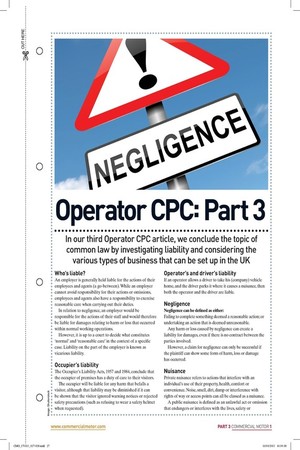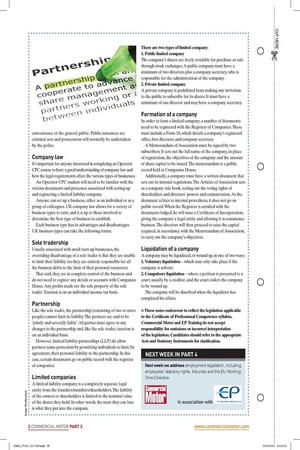erator CPC: Part 3
Page 19

Page 20

If you've noticed an error in this article please click here to report it so we can fix it.
• • • • • • • • • • • • • • • • • • • • • • • • • • • • • • • • • • • • • • • • • • • • • • • • • • • • • • • • • • • • In our third Operator CPC article, we conclude the topic of common law by investigating liability and considering the various types of business that can be set up in the UK Who's liable?
An employer is generally held liable for the actions of their employees and agents (a go-between). While an employer cannot avoid responsibility for their actions or omissions, employees and agents also have a responsibility to exercise reasonable care when carrying out their duties.
In relation to negligence, an employer would be responsible for the actions of their staff and would therefore be liable for damages relating to harm or loss that occurred within normal working operations.
However, it is up to a court to decide what constitutes 'normal' and 'reasonable care' in the context of a specific case. Liability on the part of the employer is known as vicarious liability.
Occupier's liability The Occupier's Liability Acts, 1957 and 1984, conclude that the occupier of premises has a duty of care to their visitors.
The occupier will be liable for any harm that befalls a visitor, although that liability may be diminished if it can be shown that the visitor ignored warning notices or rejected safety precautions (such as refusing to wear a safety helmet when requested).
Operator's and driver's liability If an operator allows a driver to take his (company) vehicle home, and the driver parks it where it causes a nuisance, then both the operator and the driver are liable.
Negligence Negligence can be defined as either: Failing to complete something deemed a reasonable action; or undertaking an action that is deemed unreasonable.
Any harm or loss caused by negligence can create a liability for damages, even if there is no contract between the parties involved.
However, a claim for negligence can only be successful if the plaintiff can show some form of harm, loss or damage has occurred.
Nuisance Private nuisance refers to actions that interfere with an individual's use of their property, health, comfort or convenience. Noise, smell, dirt, damp or interference with rights of way or access points can all be classed as a nuisance.
A public nuisance is defined as an unlawful act or omission that endangers or interferes with the lives, safety or convenience of the general public. Public nuisances are criminal acts and prosecution will normally be undertaken by the police.
Company law It's important for anyone interested in completing an Operator CPC course to have a good understanding of company law and how the legal requirements affect the various types of businesses.
An Operator CPC student will need to be familiar with the various documents and processes associated with setting up and registering a limited liability company.
Anyone can set up a business, either as an individual or as a group of colleagues. UK company law allows for a variety of business types to exist, and it is up to those involved to determine the best type of business to establish.
Each business type has its advantages and disadvantages. UK business types can take the following forms: Sole tradership Usually associated with small start-up businesses, the overriding disadvantage of a sole trader is that they are unable to limit their liability (so they are entirely responsible for all the business debts to the limit of their personal resources).
That said, they are in complete control of the business and do not need to register any details or accounts with Companies House. Any profits made are the sole property of the sole trader. Taxation is on an individual income tax basis.
Partnership Like the sole trader, the partnership (consisting of two or more people) cannot limit its liability. The partners are said to be 'jointly and severally liable'. All parties must agree to any changes to the partnership and, like the sole trader, taxation is on an individual basis.
However, limited liability partnerships (LLP) do allow partners some protection by permitting individuals to limit, by agreement, their personal liability to the partnership. In this case, certain documents go on public record with the registrar of companies.
Limited companies A limited liability company is a completely separate legal entity from the founders/members/shareholders. The liability of the owners or shareholders is limited to the nominal value of the shares they hold. In other words, the most they can lose is what they put into the company.
There are two types of limited company: 1. Public limited company The company's shares are freely available for purchase or sale through stock exchanges. A public company must have a minimum of two directors plus a company secretary, who is responsible for the administration of the company.
2. Private limited company A private company is prohibited from making any invitation to the public to subscribe for its shares. It must have a minimum of one director and may have a company secretary.
Formation of a company In order to form a limited company, a number of documents need to be registered with the Registrar of Companies. These must include a Form 10, which details a company's registered office, first directors, and company secretary.
A Memorandum of Association must be signed by two subscribers. It sets out the full name of the company, its place of registration, the objectives of the company and the amount of share capital to be issued. The memorandum is a public record held at Companies House.
Additionally, a company must have a written document that sets out its internal regulations. The Articles of Association acts as a company rule book, setting out the voting rights of shareholders and directors' powers and remuneration. As the document relates to internal procedures, it does not go on public record. When the Registrar is satisfied with the documents lodged, he will issue a Certificate of Incorporation, giving the company a legal entity and allowing it to commence business. The directors will then proceed to raise the capital required, in accordance with the Memorandum of Association, to carry out the company's objectives.
Liquidation of a company A company may be liquidated, or wound up, in one of two ways: 1. Voluntary liquidation — which may only take place if the company is solvent.
2. Compulsory liquidation — where a petition is presented to a court, usually by a creditor, and the court orders the company to be wound up.
The company will be dissolved when the liquidator has completed his affairs.
• These notes endeavour to reflect the legislation applicable to the Certificate of Professional Competence syllabus. Commercial Motor and EP Training do not accept responsibility for omissions or incorrect interpretation of the legislation. Candidates should refer to the appropriate Acts and Statutory Instruments for clarification.








































